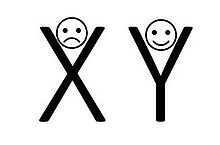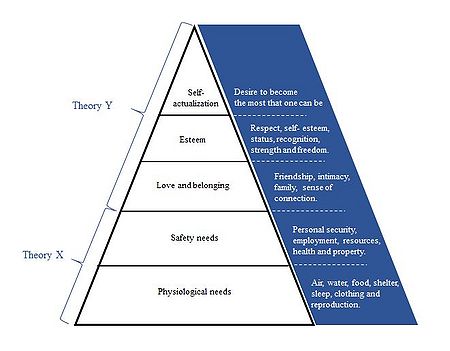McGregor's X & Y theory
(→Interpersonal relationship) |
(→Related to The hierarchy of needs) |
||
| Line 42: | Line 42: | ||
====Related to The hierarchy of needs==== | ====Related to The hierarchy of needs==== | ||
| − | The hierarchy is about how effort and motivation are correlated. This relates to the two theories, X & Y. Theory X describes motivation relative to the employees needs of financially safety. This need is one of the basic needs, and therefore the most effective incentive to make people work and demands less interpersonal effort. This relates to the two basic needs at the bottom of the pyramide, safety- and physiological needs. For obvious reasons, these needs will always be important for the employees. This means that the employer will give you as a project manager or an employee, any other reason to keep on working in that specific firm, other than money. | + | The hierarchy is about how effort and motivation are correlated. This relates to the two theories, X & Y. Theory X describes motivation relative to the employees needs of financially safety. This need is one of the basic needs, and therefore the most effective incentive to make people work and demands less interpersonal effort. This relates to the two basic needs at the bottom of the pyramide, safety- and physiological needs.<ref name="wikimaslow"> For obvious reasons, these needs will always be important for the employees. This means that the employer will give you as a project manager or an employee, any other reason to keep on working in that specific firm, other than money. |
Whereas esteem, self- actualization and love and belonging are essential motivation tools in theory Y, where the project manager use these to drive their employees to achieve success, the more basic needs of physiological and safety needs are the only needs related to theory X. Working with theory Y will therefore demand a greater amount of effort. When managers follow the theory Y in a greater extent, it will create positive ripple effects on the associated team, group, and organization. <ref name="wikimaslow"/> <ref name="simplemaslow"/> | Whereas esteem, self- actualization and love and belonging are essential motivation tools in theory Y, where the project manager use these to drive their employees to achieve success, the more basic needs of physiological and safety needs are the only needs related to theory X. Working with theory Y will therefore demand a greater amount of effort. When managers follow the theory Y in a greater extent, it will create positive ripple effects on the associated team, group, and organization. <ref name="wikimaslow"/> <ref name="simplemaslow"/> | ||
Revision as of 13:01, 24 February 2021

Douglas McGregor was a professor at Massachusetts Institute of Technology and developed in the 1960’s the two motivation theories X & Y, alongside the work of the American Psychologist Abraham Maslow. The theories described the two different manager styles, and how the project manager's primary beliefs has a big influence on how the emplyees are motivated and how the organization run. [2]
Finding how the employees are motivated, is intriguing because a motivated co- worker is more likely to help the manager achieve the project objectives.
Theory X is based on the opinion that the employees does not want to work and must be externally motivated. The X illustrates the employee crossing arms in front of him/her and symbolizes “I do not want to work”.
The alternative approach is theory Y which are more recognizable in todays manager style. Here the manager believes the employees are motivated internally by work satisfaction and are encouraged without direct supervision. The Y describes an employee with open arms. “I am happy to work.”
These theories are not particular used in practice, but are however an interesting way of viewing the two different aspects of project management and employee motivation. The motivation topic is time accurate because of the continues aiming for self- actualization. To understand how a project manager can use motivation as a tool, it is essential to consider what motivates, and which factors that influence motivation such as relationships and the managers soft skills.
Contents |
Motivation theory
Motivation and Human Relation Movement
There are several different tools and theories that point out the importance of the human aspect in project management. The ability to motivate and the relationship between employees, teams and individuals are some of the regulars.
The importance of motivation related to work, started with the human relation movement. Motivation, social relation, and employee satisfaction was investigated in relation to factory productivity in the 1930s’. Here the workers were considered in terms of their psychology rather than as replaceable bricks. The movement realized that organizational structures and processes influenced worker behavior and motivation.[3]
Elton Mayo was one of those who laid the foundation of the human relation movement and was especially interested in group effects on the behavior of individuals at work. He stressed the power of naturel groups, two-way communication, and high-quality leadership.[4]
Some of the theories that appaired after the movement was Maslow's hierarchy of needs and McGregors theory X and Y. These are one of the most known motivation theories and it is said to be among other things, the foundation for organizational studies and organizational communication studies.[5]
What motivates
In extend of the Human relation movement the Maslow hierarchy of needs was made, which laid the foundation for every human being and the universal needs of society. Humans have several needs, which follow the step of the pyramid where the basic needs at the bottom must be satisfied in some extent to be able to climb upwards. They are not fixed, but they are basic needs which influence our psychological and our tendency to growth, identity, and excellence. For individuals to complete their hierarchy, a portion of internal sensation must be met. The five steps that human motivation generally need according to Maslow are: physiological, safety, belonging and love, social needs, esteem, and self- actualization.[6] [7] These applies for theory X and Y.
Theory X
Theory X is based upon that the manager tends to think that the workers are naturally unmotivated, avoids reasonability, must be controlled, needs supervision in every step, have no work ambition and do not like employment. To be sure the workers complete their task the manager often motivates with money or penalties, also referred to as a carrot-to-stick approach. To control staff performance, tangible results are used. An example of this is sales figures. Usually this type of managing has an authoritarian style and a top- down approach. In this case the managers tend to micromanage people's work, which is often seen in process-driven workplaces. These types of workplaces are often huge organizations with a big number of employees and tight deadlines. [9] [1] [10]
Theory Y
Theory Y describes the managers to have a positive opinion of their employees, which encourage to a more trust-based relationship. This means that the employees get more responsibility and are encouraged to a more open communication. The workers are assumed to be happy to work on their own initiative, to take ownership of their own work and requires less direction. In addition, they tend to approach the work as fulfilling and challenging, and solves problems creatively and imaginary. The workers are individualized and are going towards a higher level of self-actualization, which is also referred to in the Maslow hierarchy of needs. [11] [9]
Related to The hierarchy of needs
The hierarchy is about how effort and motivation are correlated. This relates to the two theories, X & Y. Theory X describes motivation relative to the employees needs of financially safety. This need is one of the basic needs, and therefore the most effective incentive to make people work and demands less interpersonal effort. This relates to the two basic needs at the bottom of the pyramide, safety- and physiological needs.Cite error: Closing </ref> missing for <ref> tag [2] [3] [4] [6] [9] [11] [8] [7] [12] [13] [14] [5]
- ↑ Cite error: Invalid
<ref>tag; no text was provided for refs namedwikixandy - ↑ 2.0 2.1 Journal Article , Douglas McGregor - a lasting impression, Robert A Cunningham, Ivey Business Journal, Sep/Oct vol 75 issue 5, 2011 [1]
- ↑ 3.0 3.1 www.wikipedia.org, Human relations movement[2]
- ↑ 4.0 4.1 www.wikipedia.org, Elton Mayo[3]
- ↑ 5.0 5.1 5.2 www.youtube.com, Theory X and Y, Organizational communication Channel[4]
- ↑ 6.0 6.1 www.wikipedia.org, Maslow's hierarchy of needs[5]
- ↑ 7.0 7.1 Simplply Psychology, Maslow's Hierarchy of Needs by Saul McLeod, May 21, 2018.[6]
- ↑ 8.0 8.1 www.simplypsychology.org, Maslow [7]
- ↑ 9.0 9.1 9.2 www.mindtools.org, Theory X and Theory Y Understanding People's Motivations[8]
- ↑ 10.0 10.1 Readings in Managerial Psychology, Third edition from 1960, The Human Side Of Enterprise, Douglas M. McGregor, Edit by Harold J. Leavitt, Louis R. Pondy, and Davis M. Boje.[9]
- ↑ 11.0 11.1 www.hbr.org, Harvard Business Review, Beyond Theory Y by John J. Morse and Jay W. Lorsch, 1970 05[10]
- ↑ www.wikipedia.org, Interpersonal relationship [11]
- ↑ www.hbr.org, Marcus Buckingham, What Great Managers Do, Harvard Business review magazine, march 2005 [12]
- ↑ www.lucischart.com, Theory x vs theory y by Lucidchart Content Team [13]
- ↑ PMI standard, Guide to the Project Management Body of Knowledge 6th edition, by Project Management Institute, Inc 2017
- ↑ British standard, Managing successful Projects with Prince2 2017 edition, Published by TSO
- ↑ Interpersonal Relationships by Diana Jackson- Dwyer, Foundation of psychology [14]
